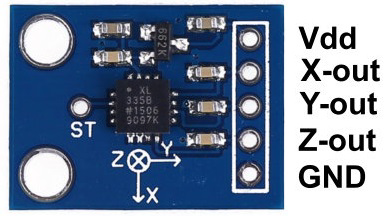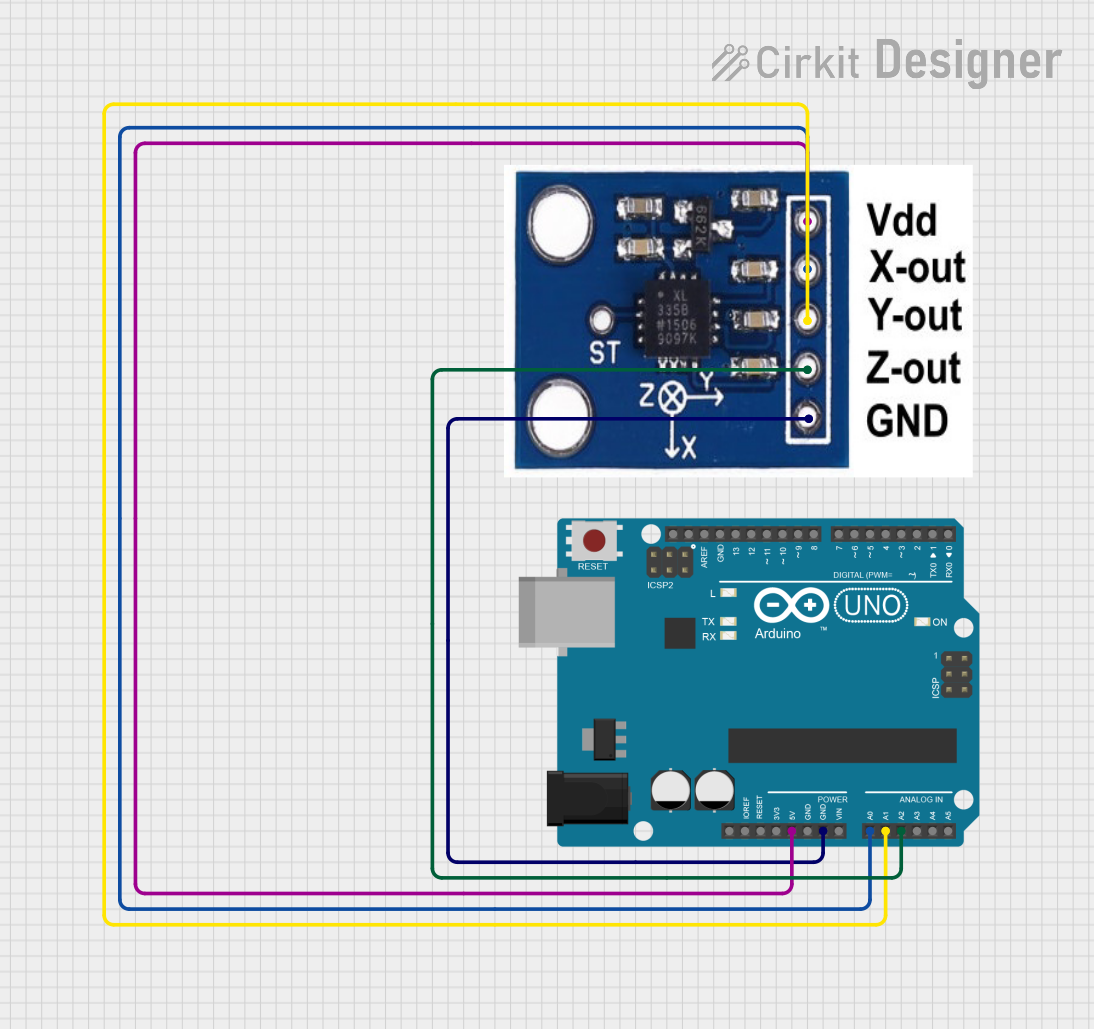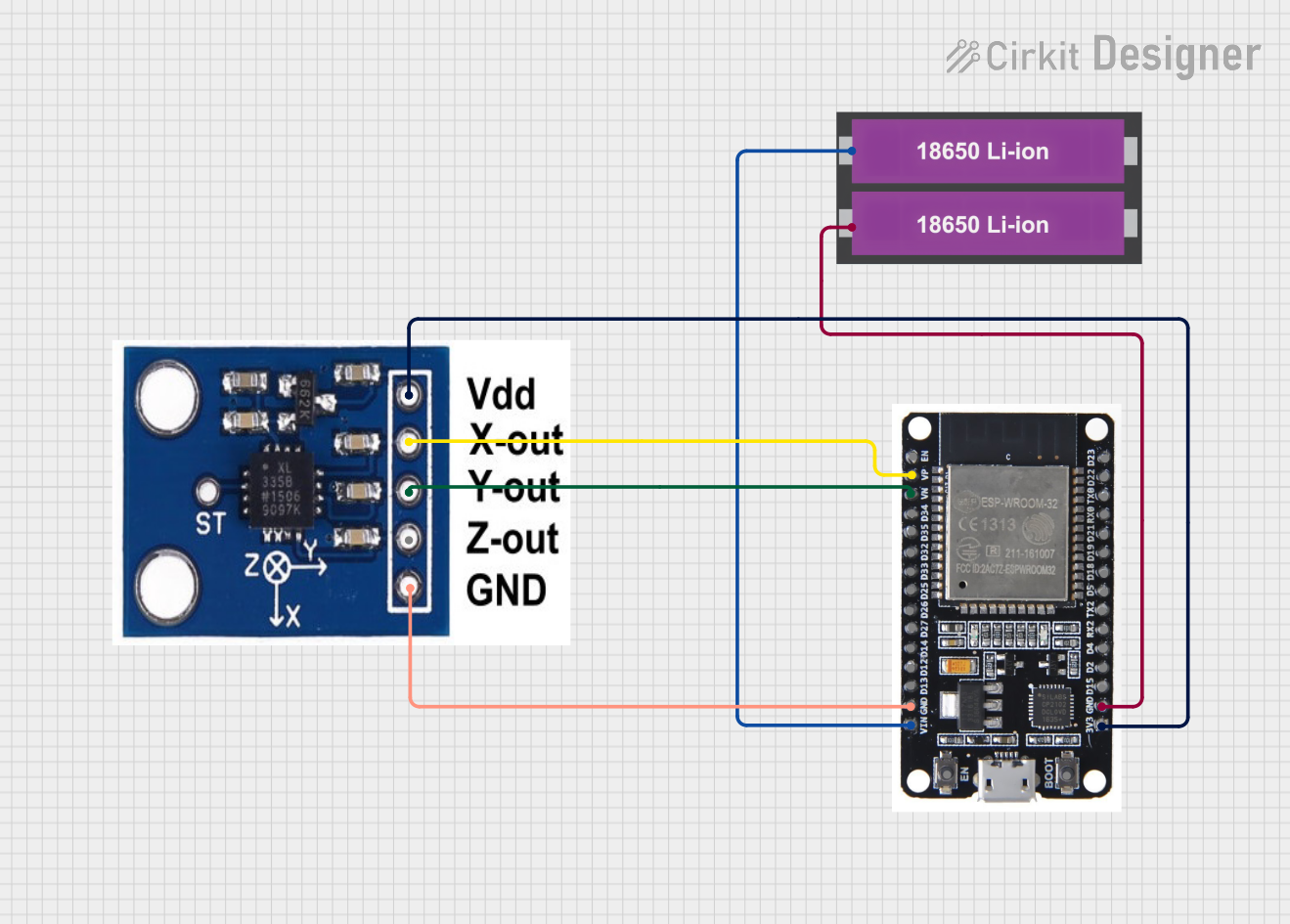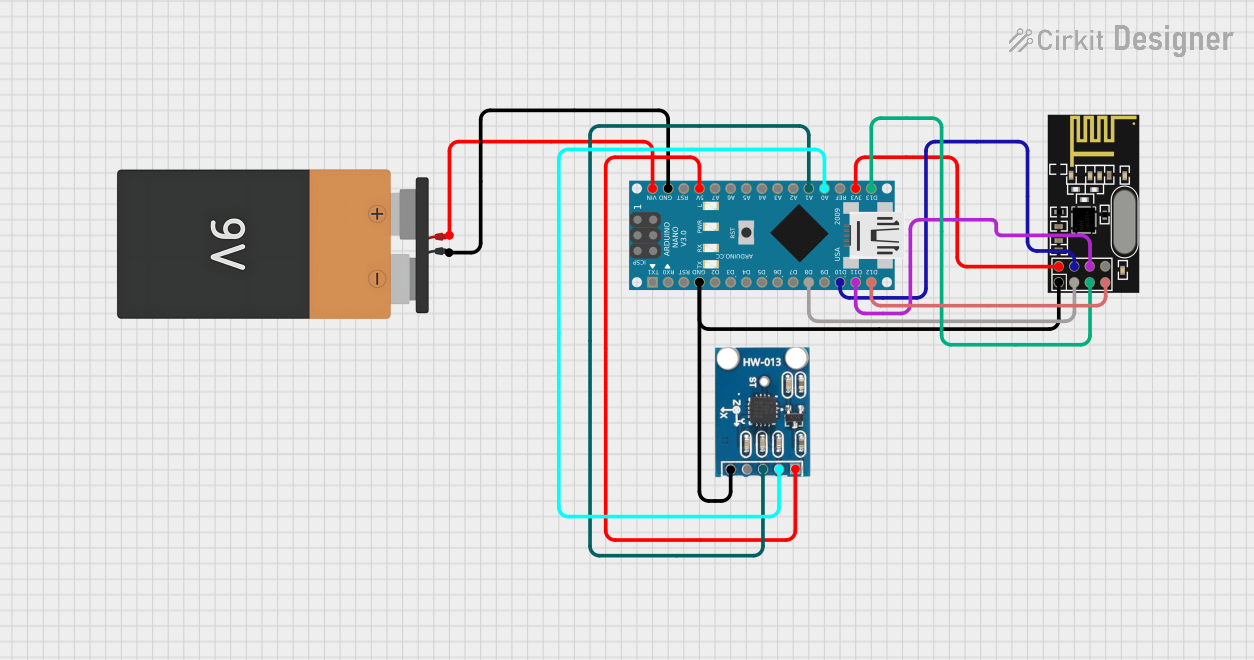
How to Use ADXXL335: Examples, Pinouts, and Specs

 Design with ADXXL335 in Cirkit Designer
Design with ADXXL335 in Cirkit DesignerIntroduction
The ADXL335 is a small, thin, low-power, 3-axis accelerometer with signal conditioned voltage outputs. It measures acceleration with a minimum full-scale range of ±3 g. It can measure the static acceleration of gravity in tilt-sensing applications, as well as dynamic acceleration resulting from motion, shock, or vibration.
Explore Projects Built with ADXXL335

 Open Project in Cirkit Designer
Open Project in Cirkit Designer
 Open Project in Cirkit Designer
Open Project in Cirkit Designer
 Open Project in Cirkit Designer
Open Project in Cirkit Designer
 Open Project in Cirkit Designer
Open Project in Cirkit DesignerExplore Projects Built with ADXXL335

 Open Project in Cirkit Designer
Open Project in Cirkit Designer
 Open Project in Cirkit Designer
Open Project in Cirkit Designer
 Open Project in Cirkit Designer
Open Project in Cirkit Designer
 Open Project in Cirkit Designer
Open Project in Cirkit DesignerCommon Applications and Use Cases
- Motion sensor for mobile devices
- Gaming and pointing devices
- Industrial instrumentation
- Robotics
- Tilt-sensing applications
Technical Specifications
Key Technical Details
- Power Supply: 1.8V to 3.6V DC
- Sensitivity: Typically 300 mV/g at 3V
- Measurement Range: ±3 g
- Bandwidth: 0.5 Hz to 1600 Hz
- Temperature Range: -40°C to +85°C
- Self-Test Feature
Pin Configuration and Descriptions
| Pin Number | Name | Description |
|---|---|---|
| 1 | VCC | Power supply (1.8V to 3.6V) |
| 2 | XOUT | X-axis output |
| 3 | YOUT | Y-axis output |
| 4 | ZOUT | Z-axis output |
| 5 | GND | Ground connection |
| 6 | ST | Self-test |
Usage Instructions
How to Use the ADXL335 in a Circuit
Powering the Device:
- Connect VCC to a 1.8V to 3.6V power supply.
- Connect GND to the system ground.
Reading the Outputs:
- Connect XOUT, YOUT, and ZOUT to analog inputs on your microcontroller, such as an Arduino UNO.
Calibration:
- Perform a calibration routine to account for zero-g offset and sensitivity.
Important Considerations and Best Practices
- Voltage Levels: Ensure that the power supply and I/O voltage levels are compatible with your microcontroller.
- Decoupling Capacitors: Use a 0.1 µF capacitor close to the VCC pin to filter out noise.
- Analog Inputs: Use analog inputs with sufficient resolution to capture the 13-bit output of the ADXL335.
- Mounting: Securely mount the ADXL335 to the object whose acceleration is being measured.
Example Code for Arduino UNO
// Include the Arduino core library
#include <Arduino.h>
// Define the analog pins connected to the accelerometer
const int xPin = A0;
const int yPin = A1;
const int zPin = A2;
void setup() {
// Initialize the serial communication
Serial.begin(9600);
}
void loop() {
// Read the raw values from the accelerometer
int xRaw = analogRead(xPin);
int yRaw = analogRead(yPin);
int zRaw = analogRead(zPin);
// Convert the raw values to 'g' values
float xG = (xRaw - 338.0) * (3.0 / 1023.0);
float yG = (yRaw - 338.0) * (3.0 / 1023.0);
float zG = (zRaw - 338.0) * (3.0 / 1023.0);
// Print the acceleration 'g' values
Serial.print("X: ");
Serial.print(xG);
Serial.print("g, Y: ");
Serial.print(yG);
Serial.print("g, Z: ");
Serial.print(zG);
Serial.println("g");
// Delay before the next reading
delay(100);
}
Note: The values 338.0 and 3.0/1023.0 in the code are based on a typical sensitivity and zero-g offset. These values should be calibrated for each ADXL335 device used.
Troubleshooting and FAQs
Common Issues Users Might Face
- Inaccurate Readings: Ensure that the accelerometer is properly calibrated.
- Noisy Signal: Use decoupling capacitors and keep the power supply stable.
- Device Not Responding: Check the connections and ensure the correct power supply voltage.
Solutions and Tips for Troubleshooting
- Calibration: Perform a calibration routine at startup and periodically during operation.
- Signal Filtering: Implement software filtering techniques to smooth out the data.
- Power Supply: Use a stable and clean power supply to minimize noise.
FAQs:
Q: Can the ADXL335 measure rotation?
- A: No, the ADXL335 is an accelerometer and measures linear acceleration. For rotation, you would need a gyroscope.
Q: What is the purpose of the self-test pin?
- A: The self-test pin (ST) can be used to verify the functionality of the accelerometer by applying a known force to the sensor.
Q: How do I convert the analog readings to 'g' values?
- A: The analog readings can be converted to 'g' values by first subtracting the zero-g offset and then scaling the result by the sensitivity factor. Calibration is necessary for accurate conversion.
Remember, this documentation is a starting point. For more detailed information, consult the ADXL335 datasheet and application notes provided by the manufacturer.